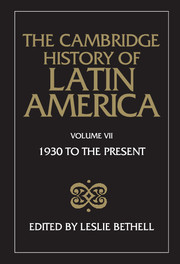7 - Nicaragua since 1930
from PART TWO - CENTRAL AMERICA
Published online by Cambridge University Press: 28 March 2008
Summary
In 1930, more than a century after independence from Spain, the status of Nicaragua as a sovereign nation was in doubt. Occupied by U.S. Marines almost continously since 1912, the country had effectively lost its political independence; indeed, a vocal minority favoured annexation by the United States. With U.S. officials responsible for most aspects of fiscal and monetary policy, Nicaragua had also lost its financial autonomy. The economy was relatively weak. The export sector (based on coffee, bananas, timber and gold) remained the driving force of the economy but lacked the dynamism of neighbouring countries: exports earned a mere $10 million a year. As a result, Nicaragua, with a population of only 680,000, had the lowest income per head in all Central America. Lack of government resources had hindered the spread of public education and the vast majority of the population remained illiterate. Moreover, the task of national integration was not yet complete. The eastern provinces bordering the Caribbean sea remained unconnected by road or rail to the capital, Managua, and the English-speaking inhabitants of the Atlantic coast, whose formal link with Great Britain had only been broken in 1894, continued to regard ‘the Spanish’ on the western side of Nicaragua as representatives of a foreign country.
By virtue of its location and unusual geographical features, Nicaragua has excited the interest of outside powers since the earliest days of Spanish colonial rule. During most of the nineteenth century after independence, it was taken for granted by interested parties that a future inter-oceanic canal would be built through Nicaragua, since the easily navigable San Juan River and Lake Nicaragua would limit major construction works to the narrow strip of land separating Lake Nicaragua from the Pacific Ocean.
- Type
- Chapter
- Information
- The Cambridge History of Latin America , pp. 317 - 366Publisher: Cambridge University PressPrint publication year: 1990
References
- 1
- Cited by



